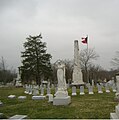
Lexington Cemetery is a private, non-profit 170-acre (69 ha) rural cemetery and arboretum located at 833 W. Main Street, Lexington, Kentucky.

The John Hunt Morgan Memorial in Lexington, Kentucky, is a monument created during the Jim Crow era, as a tribute to Confederate General John Hunt Morgan, who was from Lexington and is buried in Lexington Cemetery. The monument was originally situated on the Courthouse Lawn at the junction of North Upper and East Main Street, but was moved to Lexington Cemetery in 2018.
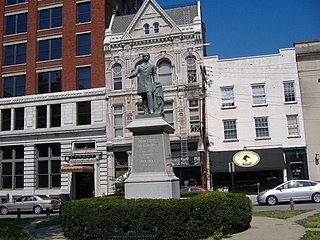
The John C. Breckinridge Memorial, originally on the courthouse lawn of Lexington, Kentucky, was placed on the National Register of Historic Places on July 17, 1997, as part of the Civil War Monuments of Kentucky MPS. It commemorates John C. Breckinridge, who was born and died in Lexington. He was Vice President for James Buchanan and ran against Abraham Lincoln in the 1860 United States presidential election, winning nine Southern states. He served in the Confederate States Army, and was the last Confederate States Secretary of War, fleeing the country after the South lost.
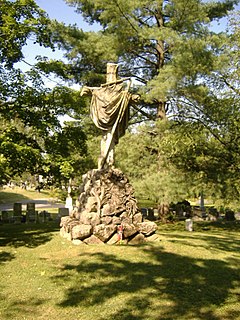
The Ladies' Confederate Memorial is an American Civil War monument erected in 1874 in Lexington Cemetery in Lexington, Kentucky. It was placed on the National Register of Historic Places on July 17, 1997, as part of the Civil War Monuments of Kentucky MPS. Unlike most Confederate monuments in Kentucky, it represents grief rather than Southern patriotism.

The Confederate Monument of Bowling Green, in Bowling Green, Kentucky, is among the sixty-one monuments of the Civil War Monuments of Kentucky Multiple Property Submission, all of which became part of the National Register of Historic Places on July 17, 1997. It is within Bowling Green's Fairview Cemetery, on the east side of the old/northern side of the cemetery.

The Confederate Monument in Georgetown is within the Georgetown Cemetery of Georgetown, Kentucky. It is an unpolished granite obelisk that is twenty feet tall, surrounded by the graves of eighteen former Confederate soldiers. The various reliefs upon the obelisk include crossed cannons, crossed muskets, a drum, an azid, and flags. It was placed on the National Register of Historic Places on July 17, 1997 as part of the Civil War Monuments of Kentucky Multiple Property Submission.

The Veteran's Monument, also called the War Between the States Veteran's Memorial, in Linden Grove Cemetery of Covington, Kentucky was built in remembrance of both Union and Confederate veterans of the American Civil War. It is one of only two memorials in the Commonwealth of Kentucky that celebrate soldiers of both sides of the conflict. The American Legion dedicated the monument on May 30, 1933, which was that year's Memorial Day.
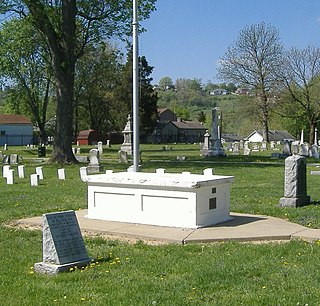
The Grand Army of the Republic Monument, in the Linden Grove Cemetery of Covington, Kentucky, was built in 1929 by the O. P. Sine of Garfield Post No. 2 of the Grand Army of the Republic, a group comprising the remaining veterans of the Union army.
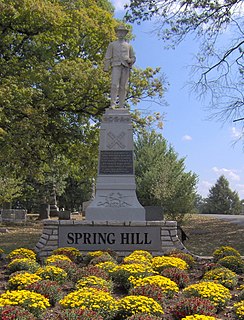
The Confederate Monument in Harrodsburg, located at the entrance to Spring Hill Cemetery in Harrodsburg, Kentucky, is a statue listed on the National Register of Historic Places. It depicts a life-sized older Confederate cavalryman standing ready.

"Bivouac of the Dead" is a poem written by Danville, Kentucky native, Theodore O'Hara to honor his fellow soldiers from Kentucky who died in the Mexican-American War. The poem’s popularity increased after the Civil War, and its verses have been featured on many memorials to fallen Confederate soldiers in the Southern United States, as well as memorials in Arlington National Cemetery, including Arlington's gateway.

The Battle of Tebb's Bend Monument in Taylor County, Kentucky, near Campbellsville, Kentucky, commemorates the Battle of Tebbs Bend, which occurred on July 4, 1863, during the Civil War. The battle was essentially a Union victory, as it greatly delayed John Hunt Morgan's famous Raid that would later go into Indiana and Ohio.

The Confederate Monument in Danville, originally located between Centre College and the First Presbyterian Church at the corner of Main and College Streets in Danville, Kentucky, was a monument dedicated to the Confederate States of America that is on the National Register of Historic Places. The monument was dedicated in 1910 by the surviving veterans of the Confederacy of Boyle County, Kentucky and the Kate Morrison Breckinridge Chapter of the United Daughters of the Confederacy (UDC). In 2021, it was relocated to a museum in Meade County, Kentucky.

The Latham Confederate Monument in Hopkinsville, Kentucky's Riverside Cemetery, is a monument on the National Register of Historic Places.

The Unknown Confederate Dead Monument in Perryville is located in the vicinity of Perryville, in Boyle County, Kentucky, United States, in the Goodknight Cemetery, a small family cemetery on private land. It is presumed to have been constructed around the year 1928, sixty-six years after the Battle of Perryville on October 8, 1862, in which the Confederate soldiers buried here anonymously died. In total, 532 Confederates died at the battle, but it is unknown how many of this number are buried here.

Lexington, Kentucky was a city of importance during the American Civil War, with notable residents participating on both sides of the conflict. These included John C. Breckinridge, Confederate generals John Hunt Morgan and Basil W. Duke, and the Todd family, who mostly served the Confederacy although one, Mary Todd Lincoln, was the first lady of the United States, wife of President Abraham Lincoln.

The Confederate Memorial Gates in Mayfield are historical monuments at the entrances to Maplewood Cemetery in Mayfield, Kentucky. The monuments were the second monument in Mayfield established by the United Daughters of the Confederacy; the first being the Confederate Memorial in Mayfield in downtown Mayfield. The gates were the third choice for monuments, chosen mostly due to their relatively low cost. The UDC intended them to not only be a monument to the residents of Graves County who served the Confederate States of America, but also a civic improvement.

The Confederate Memorial in Nicholasville is a historic statue created in the Jim Crow era and located on the Jessamine County courthouse lawn in Nicholasville, Kentucky, ten miles south of Lexington, Kentucky.

The Confederate Monument in Crab Orchard in Lincoln County, Kentucky, near Crab Orchard, Kentucky, commemorates the fallen Confederate soldiers of nearby states. Many of those buried here died at the Battle of Wildcat Mountain.
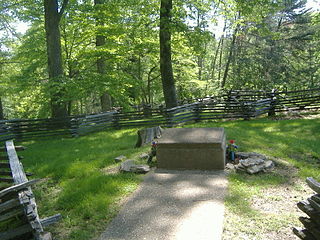
The Confederate Mass Grave Monument in Somerset in Pulaski County, Kentucky, near Nancy, Kentucky, honors the Confederate soldiers who are buried here who died at the Battle of Mill Springs. These soldiers were from Alabama, Mississippi, and Tennessee, and number over one hundred in total.

A Ladies' Memorial Association (LMA) is a type of organization for women that sprang up all over the American South in the years after the American Civil War. Typically, these were organizations by and for women, whose goal was to raise monuments in Confederate soldiers honor. Their immediate goal, of providing decent burial for soldiers, was joined with the desire to commemorate the sacrifices of Southerners and to propagate the Lost Cause of the Confederacy. Between 1865 and 1900, these associations were a formidable force in Southern culture, establishing cemeteries and raising large monuments often in very conspicuous places, and helped unite white Southerners in an ideology at once therapeutic and political.



